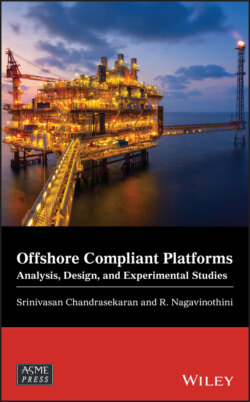Offshore Compliant Platforms

Реклама. ООО «ЛитРес», ИНН: 7719571260.
Оглавление
Srinivasan Chandrasekaran. Offshore Compliant Platforms
Table of Contents
List of Tables
List of Illustrations
Guide
Pages
Wiley‐ASME Press Series
Offshore Compliant Platforms. Analysis, Design, and Experimental Studies
List of Figures
List of Tables
Foreword by Professor Purnendu K. Das
Foreword by Dr. Atmanand N.D
Series Preface
Preface
1 Common Compliant Platforms. Summary
1.1 Introduction
1.2 Tension Leg Platforms
1.3 Guyed Tower and Articulated Tower
1.4 Floating Structures
1.5 Response Control Strategies
1.5.1 Active Control Algorithm
1.5.2 Semi‐Active Control Algorithm
1.5.3 Passive Control Algorithm
1.5.4 Friction Dampers
1.5.5 Metallic Yield Dampers
1.5.6 Viscous Fluid Dampers
1.5.7 Tuned Liquid Dampers
1.5.8 Tuned Liquid Column Damper
1.6 Tuned Mass Dampers
1.7 Response Control of Offshore Structures
1.8 Response Control of TLPs Using TMDs: Experimental Investigations
1.9 Articulated Towers
1.10 Response Control of ATs: Analytical Studies
1.11 Response Control of ATs: Experimental Studies
1.11.1 MLAT Without a TMD
1.11.2 MLAT with a TMD
2 Buoyant Leg Storage and Regasification Platforms. Summary
2.1 Background Literature
2.1.1 Buoyant Leg Structures
2.1.2 Floating Production and Processing Platforms
2.2 Experimental Setup
2.3 Experimental Investigations
2.4 Numerical Studies
2.5 Critical Observations
2.6 Stability Analysis of the BLSRP
2.7 Fatigue Analysis of the BLSRP
3 New‐Generation Platforms: Offshore Triceratops. Summary
3.1 Introduction
3.2 Environmental Loads. 3.2.1 Regular Waves
3.2.2 Random Waves
3.2.3 Wind
3.2.4 Currents
3.3 Fatigue Analysis of Tethers
3.4 Response to Regular Waves
3.5 Response to Random Waves
3.6 Response to Combined Actions of Wind, Waves, and Current
3.6.1 Deck Response
3.6.2 Buoyant Leg Response
3.6.3 Tether Tension Variation
3.7 Summary
4 Triceratops Under Special Loads. Summary
4.1 Introduction
4.1.1 Ice Load
4.1.2 Impact Load Due to Ship Platform Collisions
4.1.3 Hydrocarbon Fires
4.2 Continuous Ice Crushing
4.2.1 The Korzhavin Equation
4.2.2 Continuous Ice Crushing Spectrum
4.3 Response to Continuous Ice Crushing
4.3.1 Response to Ice Loads. 4.3.1.1 Deck and Buoyant Leg Responses
4.3.1.2 Tether Response
4.3.2 Effect of Ice Parameters. 4.3.2.1 Ice Thickness
4.3.2.2 Ice Crushing Strength
4.3.2.3 Ice Velocity
4.3.3 Comparison of Ice‐ and Wave‐Induced Responses
4.4 Response to Impact Loads
4.4.1 Parametric Studies. 4.4.1.1 Indenter Size
4.4.1.2 Collision Zone Location
4.4.1.3 Indenter Shape
4.4.1.4 Number of Stringers
4.4.2 Impact Response in the Arctic Region
4.5 Deck Response to Hydrocarbon Fires
4.6 Summary
5 Offshore Triceratops: Recent Advanced Applications. Summary
5.1 Introduction
5.2 Wind Turbines
5.3 Wind Power
5.4 Evolution of Wind Turbines
5.5 Conceptual Development of the Triceratops‐Based Wind Turbine
5.6 Support Systems for Wind Turbines
5.6.1 Spar Type
5.6.2 TLP Type
5.6.3 Pontoon (Barge) Type
5.6.4 Semi‐Submersible Type
5.6.5 Triceratops Type
5.7 Wind Turbine on a Triceratops
5.8 Response of a Triceratops‐Based Wind Turbine to Waves. 5.8.1 Free‐Decay Response
5.8.2 Response to Operable and Parked Conditions
5.8.3 Effect of Wave Heading Angles
5.8.4 PSD Plots
5.8.5 Tether Response and Service Life Estimation
5.9 Stiffened Triceratops
5.9.1 Preliminary Design
5.9.2 Response to Wave Action
5.9.3 Effect of Wave Direction
5.10 Triceratops with Elliptical Buoyant Legs
5.10.1 Conceptual Development
5.10.2 Response of a Triceratops with Elliptical Buoyant Legs to Wave Action
5.11 Summary
Model Exam Paper 1
PART A (20 × 1 = 20)
PART B (10 × 3 = 30)
PART C (5 × 10 = 50)
Model Exam Paper 1: KEY
PART A (20 × 1 = 20)
PART B (10 × 3 = 30)
PART C (5 × 10 = 50)
Model Exam Paper 2
PART A (20 × 1 = 20)
PART B (10 × 3 = 30)
PART C (5 × 10 = 50)
Model Exam Paper 2: KEY
PART A (20 × 1 = 20)
PART B (10 × 3 = 30)
PART C (5 × 10 = 50)
Model Exam Paper 3
PART A (20 × 1 = 20)
PART B (10 × 3 = 30)
PART C (5 × 10 = 50)
Model Exam Paper 3: KEY
PART A (20 × 1 = 20)
PART B (10 × 3 = 30)
PART C (5 × 10 = 50)
References
Index. a
b
c
d
e
f
g
h
i
k
l
m
n
o
p
q
r
s
t
u
v
w
WILEY END USER LICENSE AGREEMENT
Отрывок из книги
Corrosion and Materials in Hydrocarbon Production: A Compendium of Operational and Engineering Aspects
Bijan Kermani, Don Harrop
.....
Robot Manipulator Redundancy Resolution
Yunong Zhang, Long Jin
.....